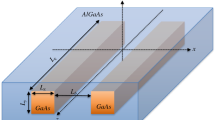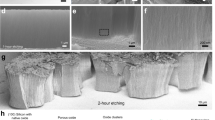Abstract
Semiconductor nanowires show promise for use in nanoelectronics, fundamental electron transport studies, quantum optics and biological sensing. Such applications require a high degree of nanowire growth control, right down to the atomic level. However, many binary semiconductor nanowires exhibit a high density of randomly distributed twin defects and stacking faults, which results in an uncontrolled, or polytypic, crystal structure. Here, we demonstrate full control of the crystal structure of InAs nanowires by varying nanowire diameter and growth temperature. By selectively tuning the crystal structure, we fabricate highly reproducible polytypic and twin-plane superlattices within single nanowires. In addition to reducing defect densities, this level of control could lead to bandgap engineering and novel electronic behaviour.
This is a preview of subscription content, access via your institution
Access options
Subscribe to this journal
Receive 12 print issues and online access
$259.00 per year
only $21.58 per issue
Buy this article
- Purchase on Springer Link
- Instant access to full article PDF
Prices may be subject to local taxes which are calculated during checkout




Similar content being viewed by others
References
Nilsson, H. A., Thelander, C., Fröberg, L. E., Wagner, J. B. & Samuelson, L. Nanowire-based multiple quantum dot memory. Appl. Phys. Lett. 89, 163101 (2006).
Duan, X., Huang, Y., Agarval, R. & Lieber, C. M. Single-nanowire electrically driven lasers. Nature 421, 241–244 (2003).
Wang, W. U., Chen, C., Lin, K. H., Fang, Y. & Lieber, C. M. Label-free detection of small-molecule–protein interactions by using nanowire nanosensors. Proc. Natl Acad. Sci. USA 102, 3208–3212 (2005).
Bao, J. et al. Optical properties of rotationally twinned InP nanowire heterostructures. Nano Lett. 8, 836–841 (2008).
Stiles, M. D. & Hamann, D. R. Electron transmission through silicon stacking faults. Phys. Rev. B 41, 5280–5282 (1990).
Stiles, M. D. & Hamann, D. R. Ballistic electron transmission through interfaces. Phys. Rev. B 38, 2021–2037 (1988).
Ikonić, Z., Srivastava, G. P. & Inkson, J. C. Electronic structure of twinning superlattices. Surf. Sci. 307–309, 880–884 (1994).
Ikonić, Z., Srivastava, G. P. & Inkson, J. C. Electronic properties of twin boundaries and twinning superlattices in diamond-type and zinc-blende-type semiconductors. Phys. Rev. B 48, 17181–17193 (1993).
Moore, A. L., Saha, S. K., Prasher, R. S. & Shi, L. Phonon backscattering and thermal conductivity suppression in sawtooth nanowires. Appl. Phys. Lett. 93, 083112 (2008).
Xiong, Q., Wang, J. & Eklund, P. C. Coherent twinning phenomena: Towards twinning superlattices iii–v semiconducting nanowires. Nano Lett. 6, 2736–2742 (2006).
Qin, A. et al. Periodically twinned nanotowers and nanodendrites of mercury selenide synthesized via a solution–liquid–solid route. Adv. Mater. 20, 768–773 (2008).
Li, Q. et al. Size-dependent periodically twinned ZnSe nanowires. Adv. Mater. 16, 1436–1440 (2004).
Hao, Y., Meng, G., Wang, Z. L., Ye, C. & Zhang, L. Periodically twinned nanowires and polytypic nanobelts of ZnS: The role of mass diffusion in vapor–liquid–solid growth. Nano Lett. 6, 1650–1655 (2006).
Wang, Y. Q., Philipose, U., Xu, T., Ruda, H. E. & Kavanagh, K. L. Twinning modulation in ZnSe nanowires. Semicond. Sci. Technol. 22, 175–178 (2007).
Trägårdh, J., Persson, A. I., Wagner, J. B., Hessman, D. & Samuelson, L. Measurements of the band gap of wurtzite InAs1–xPx nanowires using photocurrent spectroscopy. J. Appl. Phys. 101, 123701 (2007).
Koguchi, M., Kakibayashi, H., Yazawa, M., Hiruma, K. & Katsuyama, T. Crystal structure change of GaAs and InAs whiskers from zinc-blende to wurtzite type. Jpn J. Appl. Phys. 31, 2061–2065 (1992).
Joyce, H. J. et al. Twin-free uniform epitaxial GaAs nanowires grown by a two-temperature process. Nano Lett. 7, 921–926 (2007).
Minot, E. D. et al. Single quantum dot nanowire LEDs. Nano Lett. 7, 367–371 (2007).
Johansson, J. et al. Effects of supersaturation on the crystal structure of gold seeded iii–v nanowires. Cryst. Growth Des. (in the press).
Krishnamachari, et al. Defect-free InP nanowires grown in [001] direction on InP (001). Appl. Phys. Lett. 85, 2077–2079 (2004).
Wacaser, B. A, Deppert, K., Karlsson, L. S., Samuelson, L. & Seifert, W. Growth and characterization of defect free GaAs nanowires. J. Cryst. Growth 287, 504–508 (2006).
Thelander, C., Fröberg, L. E., Rehnstedt, C., Samuelson, L. & Wernersson, L.-E. Vertical enhancement-mode InAs nanowire field-effect transistor with 50-nm wrap gate. IEEE Electron. Device Lett. 29, 206–208 (2008).
Fasth, C., Fuhrer, A., Samuelson, L., Golovach, V. N. & Loss, D. Direct measurement of the spin–orbit interaction in a two-electron InAs nanowire quantum dot. Phys. Rev. Lett. 98, 266801 (2007).
Flindt, C., Sørensen, A. S. & Flensberg, K. Spin–orbit mediated control of spin qubits. Phys. Rev. Lett. 97, 240501 (2006).
Christensen, N. E., Satpathy, S. & Pawlowska, Z. Bonding and ionicity in semiconductors. Phys. Rev. B 36, 1032–1050 (1987).
Abu-Farsakh, H. & Qteish, A. Ionicity scale based on the centers of maximally localized Wannier functions. Phys. Rev. B 75, 085201 (2007).
Akiyama, T., Sano, K., Nakamura, K. & Ito, T. An empirical potential approach to wurtzite–zinc-blende polytypism in group iii–v semiconductor nanowires. J. Appl. Phys. 45, L275–L278 (2006).
Wu, H., Cha, H.-Y., Chandrashekhar, M., Spencer, M. G. & Koley, G. High-yield GaN nanowire synthesis and field-effect transistor fabrication. J. Electron. Mater. 35, 670–674 (2006).
Caroff, P. et al. High-quality InAs/InSb nanowire heterostructures grown by metal–organic vapor-phase epitaxy. Small 4, 878–882 (2008).
Jeppsson, M. et al. GaAs/GaSb nanowire heterostructures grown by MOVPE. J. Cryst. Growth 310, 4115–4121 (2008).
Johansson, J., Wacaser, B. A., Dick, K. A. & Seifert, W. Growth related aspects of epitaxial nanowires. Nanotechnology 17, S355–S361 (2006).
Johansson, J. et al. Structural properties of 〈111〉B-oriented iii–v nanowires. Nature Mater. 5, 574–580 (2006).
Glas, F., Harmand, J. C. & Patriarche, G. Why does wurtzite form in nanowires of iii–v zinc blende semiconductors? Phys. Rev. Lett. 99, 146101 (2007).
Dubrovskii, V. G., Sibirev, N. V., Harmand, J. C. & Glas, F. Growth kinetics and crystal structure of semiconductor nanowires. Phys. Rev. B (in the press).
Dubrovskii, V. G. & Sibirev, N. V. Growth thermodynamics of nanowires and its application to polytypism of zinc blende iii–v nanowires. Phys. Rev. B 77, 035414 (2008).
Karlsson, L. S. et al. Understanding the 3D structure of GaAs 〈111〉B nanowires. Nanotechnology 18, 485717 (2007).
Persson, A. I. et al. InAs1–xPx nanowires for device engineering. Nano Lett. 6, 403–407 (2006).
Magnusson, M. H., Deppert, K., Malm, J.-O., Bovin, J.-O. & Samuelson, L. Size-selected gold nanoparticles by aerosol technology. NanoStruct. Mater. 12, 45–48 (1999).
Acknowledgements
The authors thank J. Bolinsson, J. B. Wagner, T. Mårtensson and other colleagues at the Nanometer Structure Consortium for many valuable discussions. K. Nilsson and H. Nilsson are acknowledged for producing electron-beam lithography patterns as templates for ordered arrays of twin-plane superlattice nanowires. This work was carried out within the Nanometer Structure Consortium in Lund and was supported by the Swedish Foundation for Strategic Research (SSF), the Swedish Research Council (VR), the European Community (EU contract no. 015783 NODE) and the Knut and Alice Wallenberg Foundation.
Author information
Authors and Affiliations
Contributions
P.C. and K.A.D. conceived, designed and performed the experiments and co-wrote the paper. J.J. and M.E.M. contributed materials and analysis tools. K.D. and L.S. supervised the project. All authors discussed the results and commented on the manuscript.
Corresponding authors
Supplementary information
Supplementary Information
Supplementary Information (PDF 3000 kb)
Rights and permissions
About this article
Cite this article
Caroff, P., Dick, K., Johansson, J. et al. Controlled polytypic and twin-plane superlattices in iii–v nanowires. Nature Nanotech 4, 50–55 (2009). https://doi.org/10.1038/nnano.2008.359
Received:
Accepted:
Published:
Issue Date:
DOI: https://doi.org/10.1038/nnano.2008.359
This article is cited by
-
Recent progress on Majorana in semiconductor-superconductor heterostructures—engineering and detection
Science China Physics, Mechanics & Astronomy (2023)
-
A library of polytypic copper-based quaternary sulfide nanocrystals enables efficient solar-to-hydrogen conversion
Nature Communications (2022)
-
Induced structural modifications in ZnS nanowires via physical state of catalyst: Highlights of 15R crystal phase
Nano Research (2022)
-
In-situ growth of heterophase Ni nanocrystals on graphene for enhanced catalytic reduction of 4-nitrophenol
Nano Research (2022)
-
Elastic, Mechanical and Ultrasonic Properties of Nanostructured IIIrd Group Phosphides
MAPAN (2021)



